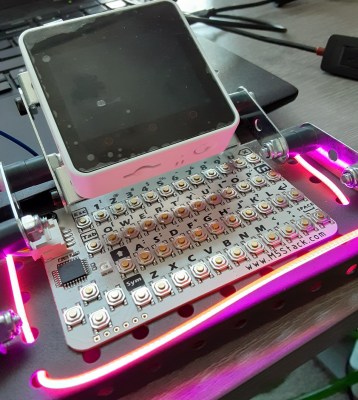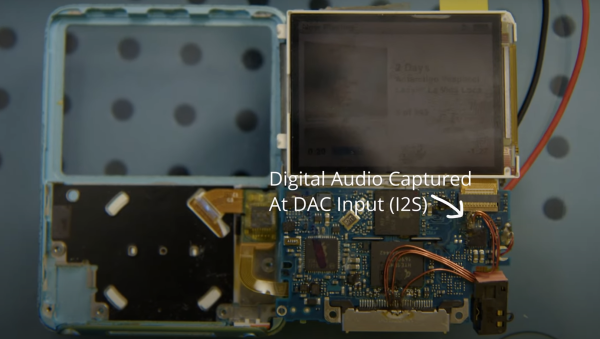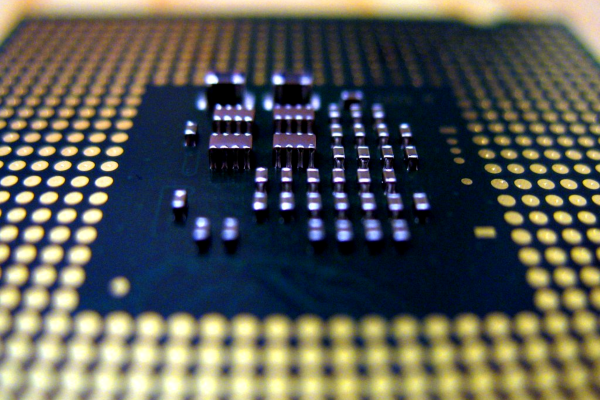The iPod Nano was one of Apple’s masterworks, but it’s really tied down by its dependence on wired headphones. At least, that’s what [Tucker Osman] must have thought, as he spent an unreasonable amount of time designing a Bluetooth mod for the 3rd gen Nano. And it’s a thing of beauty — temperamental, brutally difficult to build, and fragile in use, but still beautiful. And while some purists try to keep their signal analog, [Tucker]’s coup d’etat is to intercept the iPod’s audio signal before the DAC chip, keeping the entire signal path digital to the Bluetooth speaker. Oh, and he also managed to make the volume and track skip buttons work, back across the wireless void.
Year: 2022
Mokeylaser: A DIY Laser Engraver That You Can Easily Build
[Mark aka Mokey] borrowed his friend’s open-frame laser engraver for a while, and found it somewhat lacking in features and a bit too pricey for what it was. Naturally, he thought he could do better (video, embedded below.) After a spot of modelling in Fusion 360, and some online shopping at the usual places, he had all the parts needed to construct an X-Y bot, and we reckon it looks like a pretty good starting point. [Mark] had a Sainsmart FL55 5.5W laser module kicking around, so that was dropped into the build, together with the usual Arduino plus CNC shield combo running GRBL.
[Mark] has provided the full F360 source (see the mokeylaser GitHub) and a comprehensive bill-of-materials, weighing in at about $400, and based upon the usual 2040 aluminium extrusions. This makes MokeyLaser a reasonable starting point for further development. Future plans include upgrading the controller to something a bit more modern (and 32-bits) as well as a more powerful laser (we do hope he’s got some proper laser glasses!) and adding air assist. In our experience, air assist will definitely improve matters, clearing out the smoke from the beam path and increasing the penetration of the laser significantly. We think there is no need for more optical power (and greater risk) for this application. [Mark] says in the video that he’s working on an additional build video, so maybe come by later and check that out?
Obviously, MokeyLaser is by no means the only such beast we’ve featured, here’s the engravinator for starters. For even more minimalism, we covered a build with some smart optics doing all the work. But what if you don’t happen to have a 5W laser module “lying around” then perhaps try a more natural heat source instead?
Continue reading “Mokeylaser: A DIY Laser Engraver That You Can Easily Build”
2022 Cyberdeck Contest: RPG Character Tracker
While it would be a mistake to think there are any firm rules for what constitutes a cyberdeck, we can at least identify some common traits that would seem to give us a baseline description. For example, most deck builds we’ve seen have been fully-functional Linux computers, more often than not powered by some Raspberry Pi variant. But that doesn’t mean there isn’t room in the community for less computational powerful decks, or builds that are so bespoke that they can only perform a few selected tasks.
 As a perfect example, take a look at the RPG Character Tracker from [Melissa Matos]. You won’t find a Raspberry Pi here, nor a full operating system. Instead, we’ve got a M5Stack Core2 and an I2C CardKB Mini Keyboard wrapped up in a foldable frame made from Erector Set pieces. Add in a little LED lighting for that cyberpunk feel, and the stage is set.
As a perfect example, take a look at the RPG Character Tracker from [Melissa Matos]. You won’t find a Raspberry Pi here, nor a full operating system. Instead, we’ve got a M5Stack Core2 and an I2C CardKB Mini Keyboard wrapped up in a foldable frame made from Erector Set pieces. Add in a little LED lighting for that cyberpunk feel, and the stage is set.
So what does this diminutive build do? Well, apparently nothing right now. [Melissa] just got the hardware together and has only recently started aligning all the 1s and 0s to do her bidding. But what it’s supposed to do is clear enough: it’s intended to be an electronic companion to complex RPG tabletop games to help with things such as character creation. Sounds like it will also have a “roll dice” mode that will save you the trouble of having to crawl under the table when one of your D20s goes rogue.
While such a device could be useful for many different games, it should come as no surprise to hear that [Melissa] is currently targeting the cyberpunk Shadowrun.
Although we were particularly taken with the online tool that let you generate 3D printed organizers for all your tabletop gaming needs, we’d definitely rather have digital companions like this which would make those plastic baggies full of parts obsolete.
Future Brings CPU Modules, And The Future Is Now
Modularity is a fun topic for us. There’s something satisfying about seeing a complex system split into parts and these parts made replaceable. We often want some parts of our devices swapped, after all – for repair or upgrade purposes, and often, it’s just fun to scour eBay for laptop parts, equipping your Thinkpad with the combination of parts that fits you best. Having always been fascinated by modularity, I believe that hackers deserve to know what’s been happening on the CPU module front over the past decade.

We’ve gotten used to swapping components in desktop PCs, given their unparalleled modularity, and it’s big news when someone tries to split a yet-monolithic concept like a phone or a laptop into modules. Sometimes, the CPU itself is put into a module. From the grandiose idea of Project Ara, to Intel’s Compute Card, to Framework laptop’s standardized motherboards, companies have been trying to capitalize on what CPU module standardization can bring them.
There’s some hobbyist-driven and hobbyist-friendly modular standards, too – the kind you can already use to wrangle a powerful layout-demanding CPU and RAM combo and place it on your simple self-designed board. I’d like to tell you about a few notable modular CPU concepts – their ideas, complexities, constraints and stories. As you work on that one ambitious project of yours – you know, the one, – it’s likely you will benefit a lot from such a standard. Or, perhaps, you’ll find it necessary to design the next standard for others to use – after all, we all know there’s never too few standards! Continue reading “Future Brings CPU Modules, And The Future Is Now”
Big Noise From A 555 And A Little Embroidery
[Sam Topley] specializes in making textile based, electronic instruments and sculptures using embroidery, and this little hoop packs some serious sound (Nitter).
The circuit is a riff on a classic 555 timer circuit, which produces a signal that is modulated by applying pressure conductive textile in different ways. The signal is then piped through a system built in a visual coding interface called MaxMSP, which allows [Sam] to get specific on how to control it. The program shifts the pitch and applies filtering, producing a dynamic dial-up tone-like sound as the user interacts.
To top it off, [Sam] uses vintage resistors and tropical fish capacitors from the 60s that compliment the visual design and match the embroidery floss, they’re both beautiful and functional! This isn’t the only circuit of this kind [Sam] has made, she also produces tons of e-textile radios using similar techniques. We love how this project spans a ton of areas, analog circuitry, vintage tech, and soft circuits!
While we don’t see too many projects involving them come our way, e-textiles are certainly a fascinating topic. Our coverage of 2018’s “eTextile Spring Break” in New York is a must-read if you’re interested in exploring this technology, and the relatively recent news that MIT has developed a washable LED fabric has us hoping we’ll see more projects like this in the near future.
New Parkinson’s Test Smells Success
Parkinson’s disease affects millions of people all over the world. The degenerative condition causes characteristic tremors, trouble walking, and often comes with complications including dementia, depression, and anxiety.
One of the major challenges around Parkinson’s disease involves diagnosis. There’s no single, commonly-available test that can confirm or rule out the disease. It’s can cause particular frustration as the disease is most treatable in its early stages.
That may soon change, however. One woman identified that she seemingly had the ability to “smell” the disease in those affected, and is now working with scientists to develop a test for the condition.
Follow Your Nose
The human sense of smell, by and large, isn’t particularly impressive. It helps us enjoy the scent of fresh bread baking in an oven, or the aroma of freshly cut grass. However, as a tool for inspecting and learning about the world around us, it really comes up short.
Some of us, though, are more capable in the olfactory department than others. Joy Milne from Perth, Scotland, is one such person. She happened to detected a change in her partner’s characteristic smell, one day, and twelve years later, they were diagnosed with Parkinson’s disease.
The idea that someone could “smell” a difference with people with Parkinson’s disease is an easy one to test. When Milne eventually put the idea together that the different smell she noticed was perhaps related to her husbands condition, she quickly drew the interest of scientists. With the aid of her partner, a former doctor, she teamed up with researchers Dr. Tilo Kunath and Professor Perdita Barran to investigate further. Continue reading “New Parkinson’s Test Smells Success”
AI Midjourney Imagines “Stairway To Heaven”
This modern era of GPU-accelerated AI applications have their benefits. Pulling useful information out of mountains of raw data, alerting users to driving hazards, or just keeping an eye on bee populations are all helpful. Lately there has been a rise in attempts at producing (or should that be curating?) works of art out of carefully sculpted inputs.
 One such AI art project is midjourney, which can be played with via a Discord integration bot. That bot takes some textual input, then “dreams” with it, producing sometime uncanny, often downright disturbing images.
One such AI art project is midjourney, which can be played with via a Discord integration bot. That bot takes some textual input, then “dreams” with it, producing sometime uncanny, often downright disturbing images.
You can have a tinker with it for free, for a short while, but there is monthly cost if you want to use it ‘for real’ whatever that means. YouTuber [Daara] has been feeding the lyrics from Led Zeppelin’s “Stairway to Heaven” into it, producing a video tour of the resulting outputs for your perusal. Continue reading “AI Midjourney Imagines “Stairway To Heaven””


















